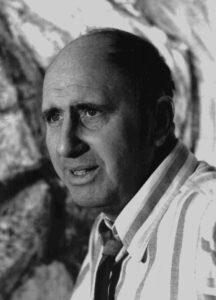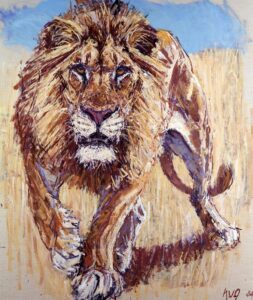

“Als ich das erste Mal eine Zeichnung von Fritz Hug sah, wusste ich, dass ich etwas Besonderes vor Augen hatte. Es war ein Löwe, und es waren alle Löwen und das ganze Wesen dieses einen Löwen. Es war der Löwe eines Löwen.
Jeder Künstler, der Lebendiges malt, hat vielleicht das eine oder andere Mal eine göttliche Hand an der Arbeit gespürt. Eine Skizze, die sich irgendwie selber zu malen scheint und wie durch Zauberei mehr Wahrheit aufnimmt, als der Künstler bewusst sehen kann. Ich denke am ehesten geschieht dies, wenn wir in grosser Eile sind, bevor das Motiv sich bewegt oder ganz verschwindet. Es bleibt nicht genug Zeit, den Verstand zu nutzen; die Hand führt einfach aus, während das Auge ausharrt. Ist der Moment vorüber – siehe da – formen die Linien und Kleckse etwas, von dem wir nicht sicher wissen, wie es zustande kam.
Für mich enthält die Arbeit von Fritz Hug diese Zauberkraft. Ob es ein Löwe ist oder eine Heuschrecke, Maus, Krähe oder Orang Utan, das Werk hat die seltsame Eigenschaft von etwas, das ihm geschehen ist, eher als dass er es geschaffen hat. Um dies immer wieder zu erreichen, muss er – so denke ich – die Dinge anders erfahren haben als wir anderen, die uns für unsere Bilder abmühen und wie Menschen denken. Ich glaube nicht, dass Hug ein Tier empfand, so wie ein Mensch ein anderes Wesen beobachtet. Ich denke, dass er vielleicht für kurze Zeit auf fast unheimliche Art eines von ihnen geworden ist. Wie immer es geschehen sein mag, wenn ich ein Werk von Fritz Hug betrachte, fühle ich nicht, dass der Künstler auf meiner Seite der Leinwand ein Bild gestaltet hat, mein Auge zu führen. Hug stand nicht draussen und schaute hinein; er war drinnen und schaute hinaus”.
Zitat von Jan Sharkey Thomas, einer bekannten kanadischen Tiermalerin.
(aus dem Buch “Fritz Hug Animal Paintings”)